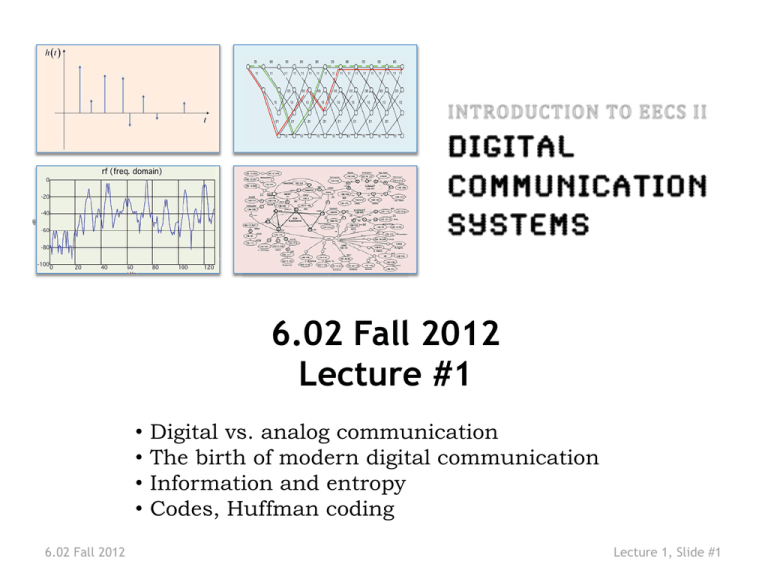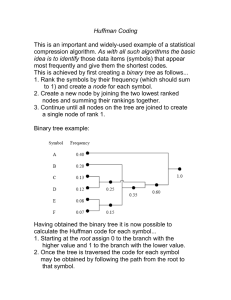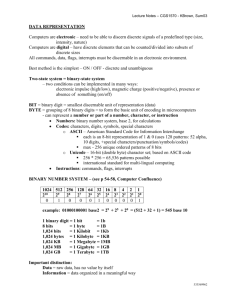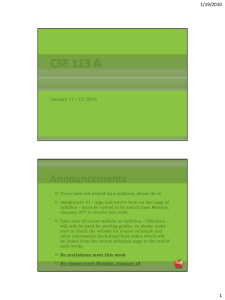6.02 Fall 2012 Lecture #1
advertisement

6.02 Fall 2012
Lecture #1
•
•
•
•
6.02 Fall 2012
Digital vs. analog communication
The birth of modern digital communication
Information and entropy
Codes, Huffman coding
Lecture 1, Slide #1
)')4,93B.,/'/--8.)5/.
• /--8.)5.'/.5.8/83I5- :9 !/2-
J B'B@9/,4' !2/--)2/0(/. K@9)-0,)48 -/8,5/.
JK/2!2 18 .<-/8,5/.JK/2BBB
– .,/' , 42/.)3
– ) ,)4<4/4( :9 !/2-
• /--8.)5.'- 33' /-02)3).')32 4 I
5- 3 18 . /!3<-/,3!2/-3/- 3/82 ,0( 4
– & ./ /.4/3/- /4( 23 18 . /!3<-/,34(4D304 4/
4( /--8.)5/.(.. ,@ B'B@).2<)')43@P.QB
– & .).9/,9).'.,/'/--8.)5/.2/334( 0(<3),(.. ,
– ) ,)4<4/4( - 33' – ,,38)4 4/2)).'4( 34'' 2).''2/:4()./-0845/.,0/: 2@
34/2' @)'4@C
6.02 Fall
Lecture 1, Slide #3
2012
6.02 Syllabus
Point-to-point communication channels (transmitterreceiver):
• Encoding information BITS
• Models of communication channels SIGNALS
• Noise, bit errors, error correction
• Sharing a channel
Multi-hop networks:
• Packet switching, efficient routing PACKETS
• Reliable delivery on top of a best-efforts network
6.02 Fall 2012
Lecture 1, Slide #4
SamuelBB/23 • .9 .4 JQXSR/.:23@04 .4MQ@VTW).QXTPK4( -/34025,!/2-
/! , 42),4 , '20(<@).,8).'+ <3@:)2 22.' - .43@
, 42/-'. 43@-2+).' 9) 3@2 ,<3@C@./23 / ?
• /2+ 52 , 33,<4/ 34,)3(4( 4 (./,/'<
• & 2).)5,3428'', 3@4 , '20(<:318)+,</04 .:) ,<
0,/< – 2.3I4,.5, 7 -043QXUWJQV(/8234/3 .YX:/23!2/-8 .
)4/2)4/2 3) .48(..?K@QXUX@QXVU@#.,,<38 33).QXVVJX:/23G
-).84 K
– 2.3I/.5. .4,).QXVQJ " 59 ,< . 4( /.<;02 33K
– 2.3I)#QYPR
• , '20(<42.3!/2- /--8.)5/.J42.3I4,.55- !2/-QP<3
<3()04/-).84 3<4 , '20(K./-- 2 @,3/30822 -*/2
9 ,/0- .43).4( /2<L025 J .2<@ ,9).@ 9)3) @80).@CK
6.02 Fall 2012
Lecture 1, Slide #7
34I!/2:2QPP< 23
• )
– , 0(/. JE
-02/9 - .4). , '20(<F@04 .4M
QWT@TUV@ ,,QXWVK
– )2 , 334 , '20(<J2/.)QYPQK
– 2)/J 33 . .QYPVK
– 2)/J2-342/.'QYSSK
– , 9)3)/.2/35.'<4( JQYSVK
– C
• ,,3',;</!2 3 2( 23
– <18)34@/ @24, <@C
6.02 Fall 2012
Lecture 1, Slide #13
Claude E. Shannon, 1916-2001
QYSW34 234( 3)3@ 04@
.42/8 00,)5/./!//, .
,' 24/,/'))28)43@.9) 9 23B
2<).%8 .5,).)')4,)28)4 3)'.B
E/34)-0/24.434 234( 3)3/!4( .482<F
QYTP(@4( 04@
/.,<= 4( <.-)3/! . ,).
Photograph © source unknown. All rights reserved.This
content is excluded from our Creative Commons license.
0/08,5/.3B
For more information, see http://ocw.mit.edu/fairuse.
MIT faculty
/). ,,3).QYTPB
1956-1978
E-4( -5,4( /2</!2<04/'20(<FQYTUGQYTY
6.02 Fall 2012
Lecture 1, Slide #14
A probabilistic theory requires at least a one-slide
checklist on Probabilistic Models!
•
•
•
•
•
•
•
.)9 23 /! , - .42</84/- 33Q@3R@C@3@CB. ./.,</. /84/- ). ( ;0 2)- .4/228./!4( -/ ,B
9 .43@@@C2 383 43/!/84/- 3B 3< 9 .4(3/822 )!4( /84/- /!4( ;0 2)- .4,) 3).B
9 .43!/2-.E,' 2F/!3 43@)B B@J8.)/.@,3/:2)7 .ZK)3.
9 .4@J).4 23 5/.@,3/:2)7 .K)3. 9 .4@J/-0, - .4@
,3/:2)7 .K)3. 9 .4B/.4( .8,,3 42 ,3/ 9 .43B
2/),)5 32 #. /. 9 .43@38(4(4P\JK\Q@JK[Q@.
JZK[JKZJK)!.2 -848,,< ;,83)9 @)B B)



